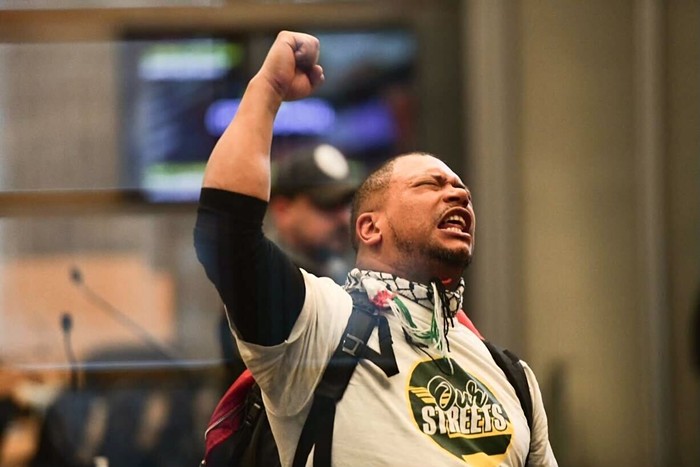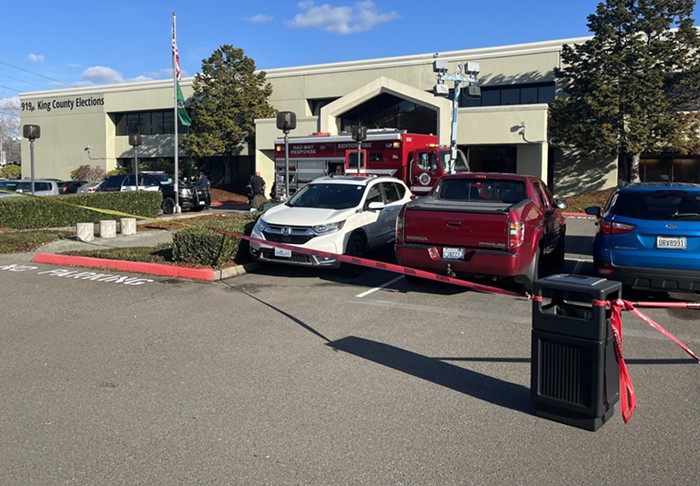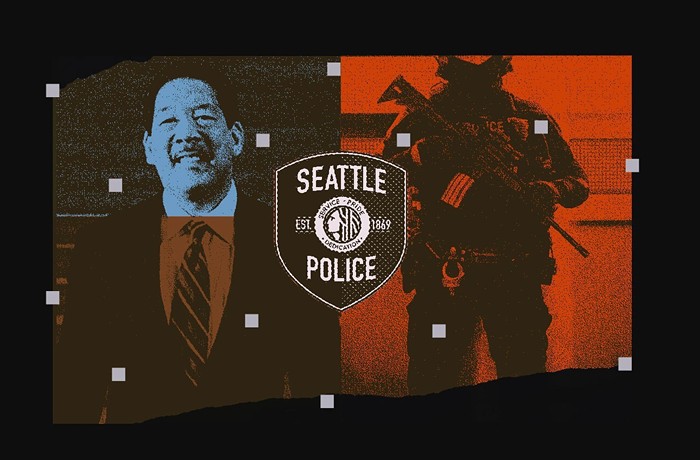There is an oblong region, from the beginning of the Duwamish to the end of Star Lake, called Green River Land. The center of this place is SeaTac: Its economy is run by the international airport, its municipal sport is pulltabs, and the primary mode of transportation is the pickup truck. The climate of Green River Land is torpid, with a joyless sun that never rises to the middle of the sky but is always low along the end of the world.
Dusk never leaves Green River Land, but sickly seeps into all of its half-empty bars and cheap hotels, clinging over trailer parks like fog over a graveyard. As sleeping sickness is the primary health risk for tropic-addled countries in the middle of darkest Africa (sleeping sickness is spread by huge, bloodthirsty tsetse flies), this region suffers from nightmares, which frequently infect the sleep of its citizens as jet planes howl over small homes.
In ancient societies there were places that villagers designated as their "negative land"--places where, to protect themselves from evil and misfortune, they buried live twins, hermaphrodites, and other newborn monsters. The elders of these small societies would warn the young to stay clear of the negative area, from whence, at night, villagers would hear the hell-howl of wild animals. Green River Land serves a similar function to modern Seattle. Seattle is deathless, with a quality of light that is as angular as Green River Land, but instead inspires poetry and romance rather than rape fantasies and murder.
Most of us who arrived in Seattle in the late '80s and '90s have a vague idea about this place and its history. But with the recent arrest of Gary Leon Ridgway, we have an opportunity to learn more about the negative side of our positive city. What is offered here is a basic guide to this underworld--the locations where bodies were dumped and a serial killer was spawned. For the sake of sanity and sound sleep, I recommend you visit these places during the day.
All of Seattle's death is exported to Green River Land. The first glimmerings of its miserable reputation came on July 15, 1982, when two boys on a bridge spotted a corpse in the Green River. Soon after this discovery, four more bodies were found along the river. For the next two years, bodies of murdered women continually surfaced all over what became Green River Land.
Most of us who arrived in Seattle in the late '80s and '90s have a vague idea about this place and its history. But with the recent arrest of Gary Leon Ridgway, we have an opportunity to learn more about the negative side of our positive city. What is offered here is a basic guide to this underworld--the locations where bodies were dumped and a serial killer was spawned. For the sake of sanity and sound sleep, I recommend you visit these places during the day.
•••
1. There is nothing more bleak than this part of the river. It's between Meeker Street Bridge (where the first corpse was spotted) and the former site of PD&J Meat Company (where the second corpse was spotted). The doomed cows, the dead tractors, the fishing shacks, the low clouds, the bad land, the bloody brambles, the lonely farmhouse (which seems to have been placed here by some act of sorcery rather than by the hard work of a farmer)--all of it convinces you that Satan does exist, and operates in places like this.
While driving beside the winding river on Frager Road South, you feel a general evil (the river is ugly and exhausted). But when you pass Meeker Street Bridge and approach the very spot where Frank Linard, a worker from the slaughterhouse, discovered the second corpse during his lunch break on August 12, 1982, you're overwhelmed by a sense that this is where all the river's evil is concentrated. There are no trees here, no cover--it is wild yet empty. Not the most practical place to dump a murder victim (or victims). Obviously, it was not criminal cunning or logic that drew the killer to this desolate spot by the slaughterhouse, but phantom forces beneath the dark, green river.
2. On April 17, 1983, 18-year-old Maria Malvar and her pimp/boyfriend, Bobby Woods, were working Pacific Highway South when a man in a green pickup truck with a camper opened his door for Maria. To ensure that his investment was safely returned, Bobby followed the green pickup truck. The driver in the pickup truck realized he was being followed, and sped up. The pimp realized something bad was going down, and so pursued the pickup. But a red light near South 216th Street stopped Bobby, and the truck vanished into the void. Maria did not return that night, nor the next day. The worried pimp informed Maria's father, Joe Malvar, about what had happened, and they drove around Green River Land looking for the green pickup. After some hours, they found it parked in front of this home, which was owned by Gary Leon Ridgway, the man now charged with four of the Green River murders.
It is the ugliest house on this cul-de-sac, which is just off Military Road South. It's gray and miserable, with the sound of traffic howling from behind the concrete wall that divides it from I-90. Only few turns and minutes separate this house from the spot where the first Green River body was found.
3. Despite the hard evidence against Gary Leon Ridgway, one is surprised by both the media and police department's commitment to the idea that there was just one or maybe two killers who committed what is officially 49 murders, but is unofficially nearer to 100 murders. A drive around Green River Land gives the distinct impression that one out of every four homes harbors a killer who contributed a few corpses to the long list of the dead.
At the height of the murders, the police had 978 prime suspects and over 4,000 persons of interest. One figure published in the Seattle Post-Intelligencer had the number of persons of interest at 20,000--indeed, at the time of the murders, the population of SeaTac was under 20,000. Out of this veritable city of suspects, only one, Gary Leon Ridgway, has been physically linked to the murders. And this is where he worked during the early 1980s, painting trucks during the night shift. The bleak bulk of the factory--which is near the Museum of Flight--stands at the bank of a lake-sized parking lot, which, even to this day, is dominated by a fleet of pickup trucks.
4. Now called International Boulevard, Pacific Highway South was known to the underworld as "the strip." But the best name for this dreary stretch of highway is "Last-Seen Strip." The convenience stores ("she went to get cigarettes"), the taverns ("she finished work and left"), the fancy hotels further south ("she called me from the lobby"), the cheap hotels and motels ("she left the room and was picked up by a man in a pickup truck") such as this one, Ben Carol Motel, were places where many of the victims were last seen.
The famously exhausted sign for Ben Carol Motel stands at 14110 Pacific Highway South, looking like a decomposed butler for a Transylvanian castle, welcoming the unfortunate into the dead heart of SeaTac. If one looks north from this sign they will see downtown Seattle, which seems to float in a haze that is caused not so much by geographical distance as by the preternatural distance between life and death, heaven and hell. It is no wonder that, during the peak period of the murders, psychics and hypnotists and hounds played important roles in the police investigations: Only those with a sixth sense can guide you through the maze of Green River Land.
5. The corpses that the crazed killer (or killers) dumped all over Green River Land seemed to be discovered by the most normal citizens doing the most normal things. On August 11, 1983, a man picking apples found a skeleton near the airport. On February 14, 1984, a man looking for moss found skeletal remains in a park near I-90. On March 13, 1984, a soldier heading to the mountains stopped, walked into a wooded area near I-90, and began to relieve himself. As he urinated he discovered a human skeleton. Just six days later, on March 19, a dog owned by a man working at this Little League baseball field (which is on 16th Avenue South) returned from the woods with a human leg bone in its mouth.
The boys who played on the baseball field often complained about the bad smell wafting from the nearby woods. At one point the smell got so bad, the games were canceled. The discovery of the corpse explained the smell. The discovery of another corpse on the following day explained why the smell was so strong. Two weeks after the dog discovered the corpse behind the baseball field, a man looking for wild mushrooms in a wooded area near Star Lake found another skeleton not far from where, just six months earlier, a man chasing a chicken had found a skeleton.
6. Because most of the bodies were dumped in popular dump sites around Green River Land, the detectives working the case suspected that the killer was on a twisted moral mission. This theory was justified on June 14, 1985, when the police found a bible in the van of a suspect, Richard Terry Horton (he kidnapped a prostitute and threatened her with a knife), with this terrifying passage underlined in the Book of Ezekiel, Chapter 16:
38: And I will judge thee, as women that break wedlock and shed blood; and I will give thee blood in fury and jealousy. 39: And I will also give thee into their hand, and they shall throw down thine eminent place, and shall break down thy high places: they shall strip thee also of thy clothes, and shall take thy fair jewels, and leave thee naked and bare....42: So will I make my fury toward thee to rest, and my jealousy shall depart from thee, and I will be quiet, and will be no more angry.
However, the bible freak, who was also a medic for the Navy, turned out not to be the serial killer the cops were looking for. According to Navy records, he was at sea during the time when most of the women were last seen.
7. On December 14, 1999, a 32-year-old Algerian named Ahmed Ressam attempted to enter America through Port Angeles with more than 100 pounds of explosives. He looked sick and suspicious, so the U.S. Customs agents inspected his vehicle and discovered the components for mass destruction. Ahmed Ressam, who was planning to blow up either the millennial festival under the Space Needle or LAX airport (most likely LAX), went on trial and, on April 4, 2001, was convicted of attempting to transport bomb materials into the United States. He is now serving part of his sentence here in Green River Land, at the Federal Detention Center (2425 South 200th Street), which was built in 1997. The FDC is only a half mile's walk from a multiple-body dump site just south of the airport on 28th Avenue South and South 194th Street.
8. Through the years, the Sea-Tac International Airport has grown and has needed more space for its sophisticated operations. To accommodate this expansion, the Port of Seattle bought whole neighborhoods and emptied them of all human life, thus producing something of a moat around the airport's high-tech bulk. In this dead area, nature returned not as real nature, but as post-apocalyptic nature. This was the kind of growth you would expect to find after a world war eliminated human productivity and wild nature re-thrived on what used to be manicured lawns, smoothly paved roads, solid and happy homes. Add some garbage to this setting (the dead area around the airport is used for illegal dumping), and you have opened the gates of hell.
The ultra-urban international airport (nothing is more cosmopolitan than an international airport--indeed, unlike Seattle, Sea-Tac Airport has a subway) created a new type of rural space that no one could read, understand, or even police. Gary Leon Ridgway loved these strange, new, enigmatic spaces. As an avid scavenger, he visited them searching for junk, which he would then sell at local swap meets; as a family man, he had picnics and outdoor sex with his wife in these spaces; and, consequently, as an alleged madman, this is where he may have strangled so many young women to death.



















